2009 MERCEDES-BENZ E-CLASS ESTATE brake
[x] Cancel search: brakePage 327 of 373
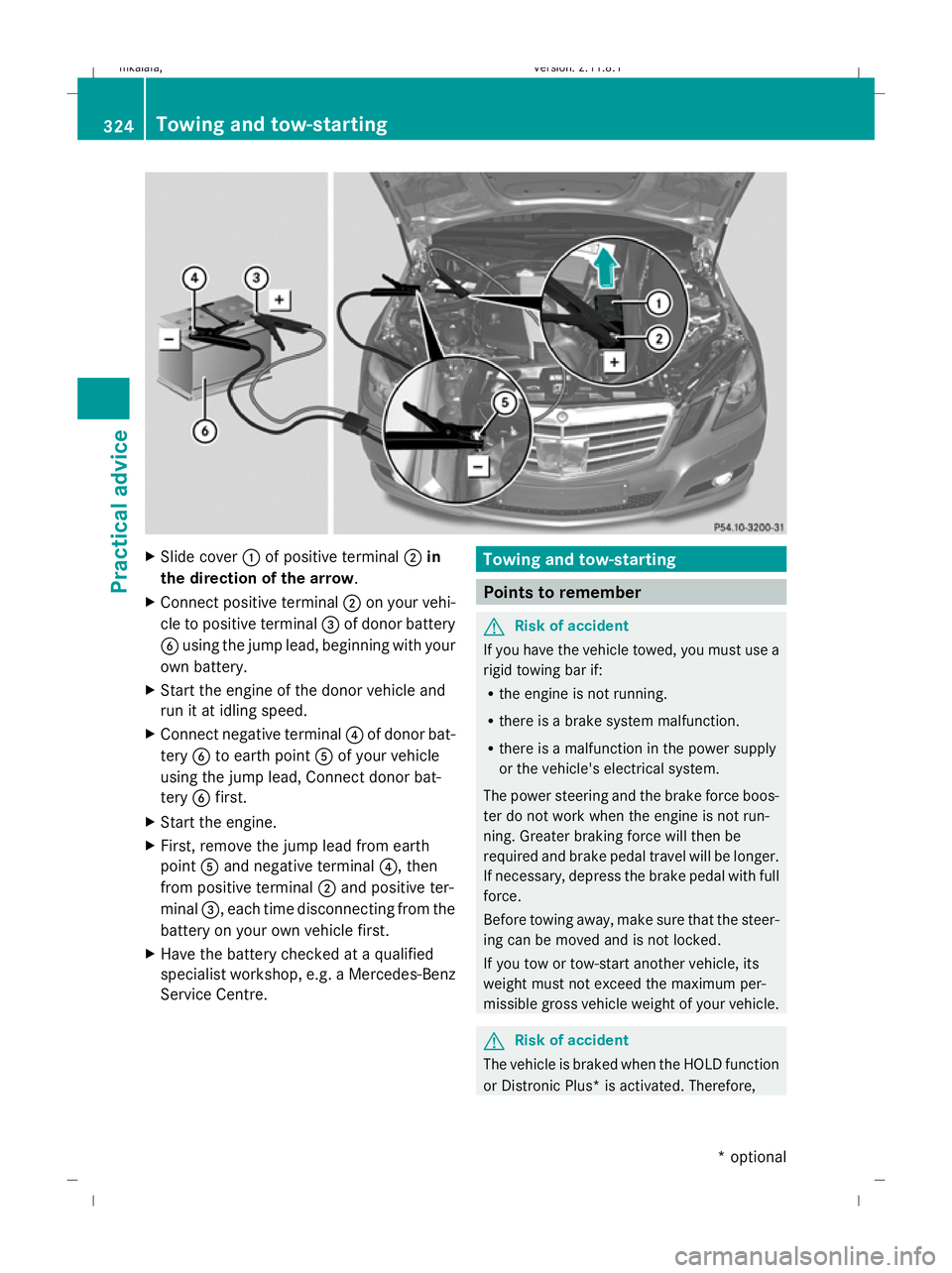
X
Slide cover :of positive terminal ;in
the direction of the arrow .
X Connect positive terminal ;on your vehi-
cle to positive terminal =of donor battery
B using the jump lead, beginning with your
own battery.
X Start the engine of the donor vehicle and
run it at idling speed.
X Connect negative terminal ?of donor bat-
tery Bto earth point Aof your vehicle
using the jump lead, Connect donor bat-
tery Bfirst.
X Start the engine.
X First, remove the jump lead from earth
point Aand negative terminal ?, then
from positive terminal ;and positive ter-
minal =, each time disconnecting from the
battery on your own vehicle first.
X Have the battery checked at a qualified
specialist workshop, e.g. a Mercedes-Benz
Service Centre. Towing and tow-starting
Points to remember
G
Risk of accident
If you have the vehicle towed, you must use a
rigid towing bar if:
R the engine is not running.
R there is a brake system malfunction.
R there is a malfunction in the power supply
or the vehicle's electrical system.
The power steering and the brake force boos-
ter do not work when the engine is not run-
ning. Greater braking force will then be
required and brake pedal travel will be longer.
If necessary, depress the brake pedal with full
force.
Before towing away, make sure that the steer-
ing can be moved and is not locked.
If you tow or tow-start another vehicle, its
weight must not exceed the maximum per-
missible gross vehicle weight of your vehicle. G
Risk of accident
The vehicle is braked when the HOLD function
or Distronic Plus* is activated. Therefore, 324
Towing and tow-startingPractical advice
* optional
212_AKB; 2; 4, en-GB
mkalafa
,V ersion: 2.11.8.1
2009-05-05T14:17:16+02:00 - Seite 324
Dateiname: 6515346702_buchblock.pdf; erzeugt am 07. May 2009 14:17:27; WK
Page 328 of 373
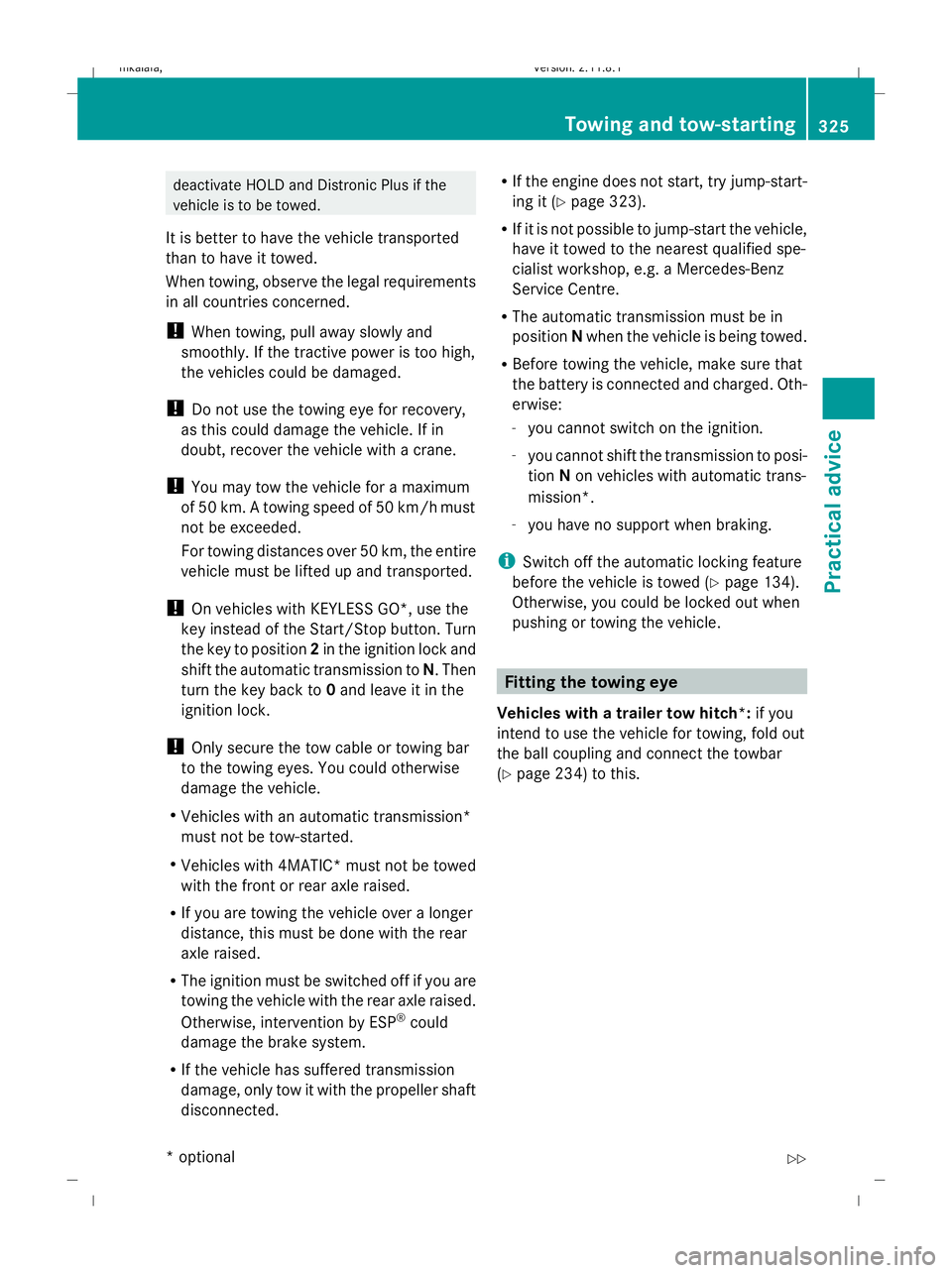
deactivate HOLD and Distronic Plus if the
vehicle is to be towed.
It is better to have the vehicle transported
than to have it towed.
When towing, observe the legal requirements
in all countries concerned.
! When towing, pull away slowly and
smoothly. If the tractive power is too high,
the vehicles could be damaged.
! Do not use the towing eye for recovery,
as this could damage the vehicle. If in
doubt, recover the vehicle with a crane.
! You may tow the vehicle for a maximum
of 50 km. A towing speed of 50 km/ hmust
not be exceeded.
For towing distances over 50 km, the entire
vehicle must be lifted up and transported.
! On vehicles with KEYLESS GO*, use the
key instead of the Start/Stop button. Turn
the key to position 2in the ignition lock and
shift the automatic transmission to N. Then
turn the key back to 0and leave it in the
ignition lock.
! Only secure the tow cable or towing bar
to the towing eyes. You could otherwise
damage the vehicle.
R Vehicles with an automatic transmission*
must not be tow-started.
R Vehicles with 4MATIC* must not be towed
with the front or rear axle raised.
R If you are towing the vehicle over a longer
distance, this must be done with the rear
axle raised.
R The ignition must be switched off if you are
towing the vehicle with the rear axle raised.
Otherwise, intervention by ESP ®
could
damage the brake system.
R If the vehicle has suffered transmission
damage, only tow it with the propeller shaft
disconnected. R
If the engine does not start, try jump-start-
ing it (Y page 323).
R If it is not possible to jump-start the vehicle,
have it towed to the nearest qualified spe-
cialist workshop, e.g. a Mercedes-Benz
Service Centre.
R The automatic transmission must be in
position Nwhen the vehicle is being towed.
R Before towing the vehicle, make sure that
the battery is connected and charged. Oth-
erwise:
-you cannot switch on the ignition.
- you cannot shift the transmission to posi-
tion Non vehicles with automatic trans-
mission*.
- you have no support when braking.
i Switch off the automatic locking feature
before the vehicle is towed (Y page 134).
Otherwise, you could be locked out when
pushing or towing the vehicle. Fitting the towing eye
Vehicles with a trailer tow hitch*: if you
intend to use the vehicle for towing, fold out
the ball coupling and connect the towbar
(Y page 234) to this. Towing and tow-starting
325Practical advice
* optional
212_AKB; 2; 4, en-GB
mkalafa,
Version: 2.11.8.1 2009-05-05T14:17:16+02:00 - Seite 325 Z
Dateiname: 6515346702_buchblock.pdf; erzeugt am 07. May 2009 14:17:27; WK
Page 329 of 373
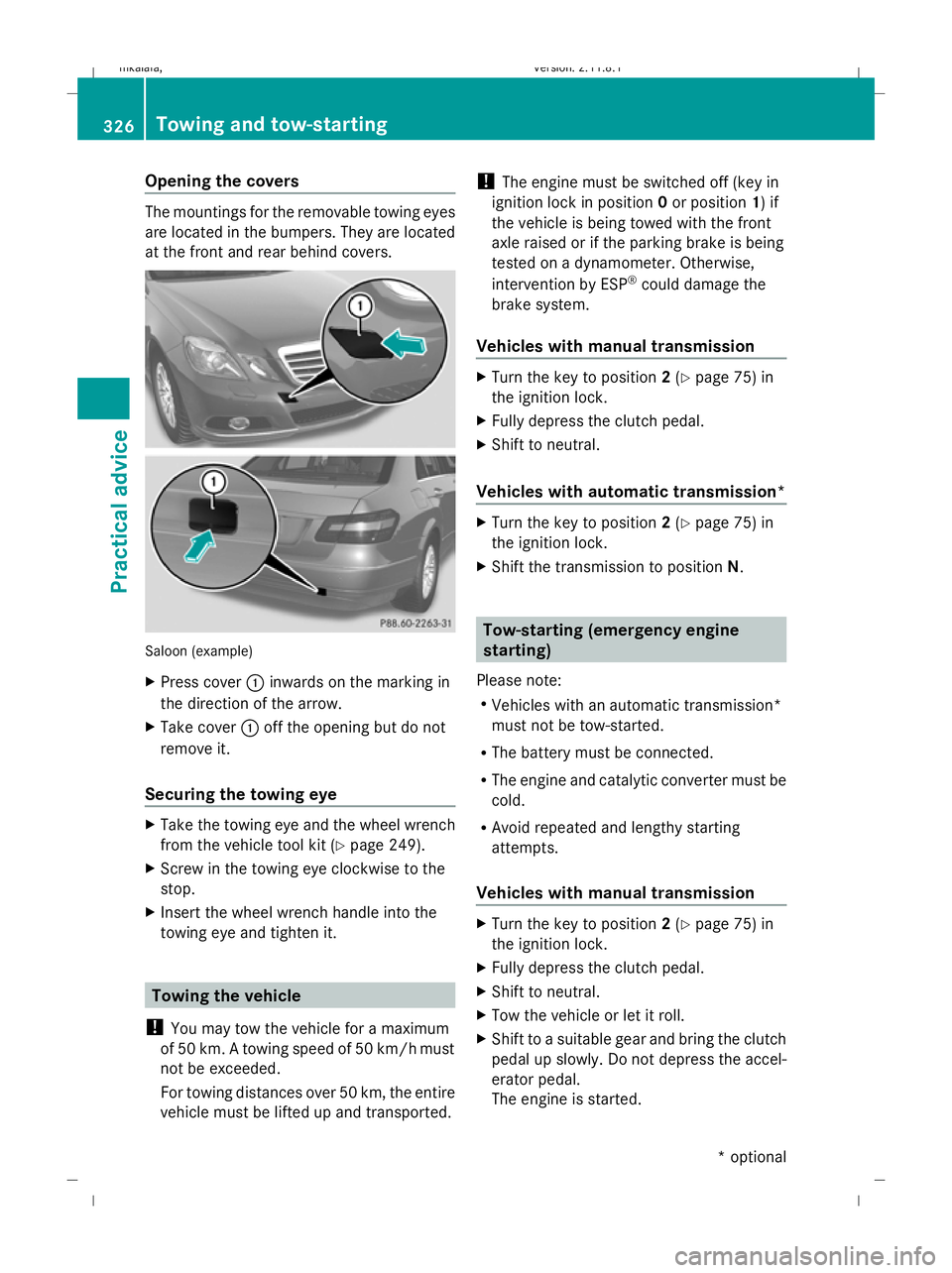
Opening the covers
The mountings for the removable towing eyes
are located in the bumpers. They are located
at the front and rear behind covers. Saloon (example)
X
Press cover :inwards on the marking in
the direction of the arrow.
X Take cover :off the opening but do not
remove it.
Securing the towing eye X
Take the towing eye and the wheel wrench
from the vehicle tool kit (Y page 249).
X Screw in the towing eye clockwise to the
stop.
X Insert the wheel wrench handle into the
towing eye and tighten it. Towing the vehicle
! You may tow the vehicle for a maximum
of 50 km. A towing speed of 50 km/hm ust
not be exceeded.
For towing distances over 50 km, the entire
vehicle must be lifted up and transported. !
The engine must be switched off (key in
ignition lock in position 0or position 1) if
the vehicle is being towed with the front
axle raised or if the parking brake is being
tested on a dynamometer. Otherwise,
intervention by ESP ®
could damage the
brake system.
Vehicles with manual transmission X
Turn the key to position 2(Y page 75) in
the ignition lock.
X Fully depress the clutch pedal.
X Shift to neutral.
Vehicles with automatic transmission* X
Turn the key to position 2(Y page 75) in
the ignition lock.
X Shift the transmission to position N. Tow-starting (emergency engine
starting)
Please note:
R Vehicles with an automatic transmission*
must not be tow-started.
R The battery must be connected.
R The engine and catalytic converter must be
cold.
R Avoid repeated and lengthy starting
attempts.
Vehicles with manual transmission X
Turn the key to position 2(Y page 75) in
the ignition lock.
X Fully depress the clutch pedal.
X Shift to neutral.
X Tow the vehicle or let it roll.
X Shift to a suitable gear and bring the clutch
pedal up slowly. Do not depress the accel-
erator pedal.
The engine is started. 326
Towing and tow-startingPractical advice
* optional
212_AKB; 2; 4, en-GB
mkalafa,
Version: 2.11.8.1 2009-05-05T14:17:16+02:00 - Seite 326
Dateiname: 6515346702_buchblock.pdf; erzeugt am 07. May 2009 14:17:28; WK
Page 336 of 373
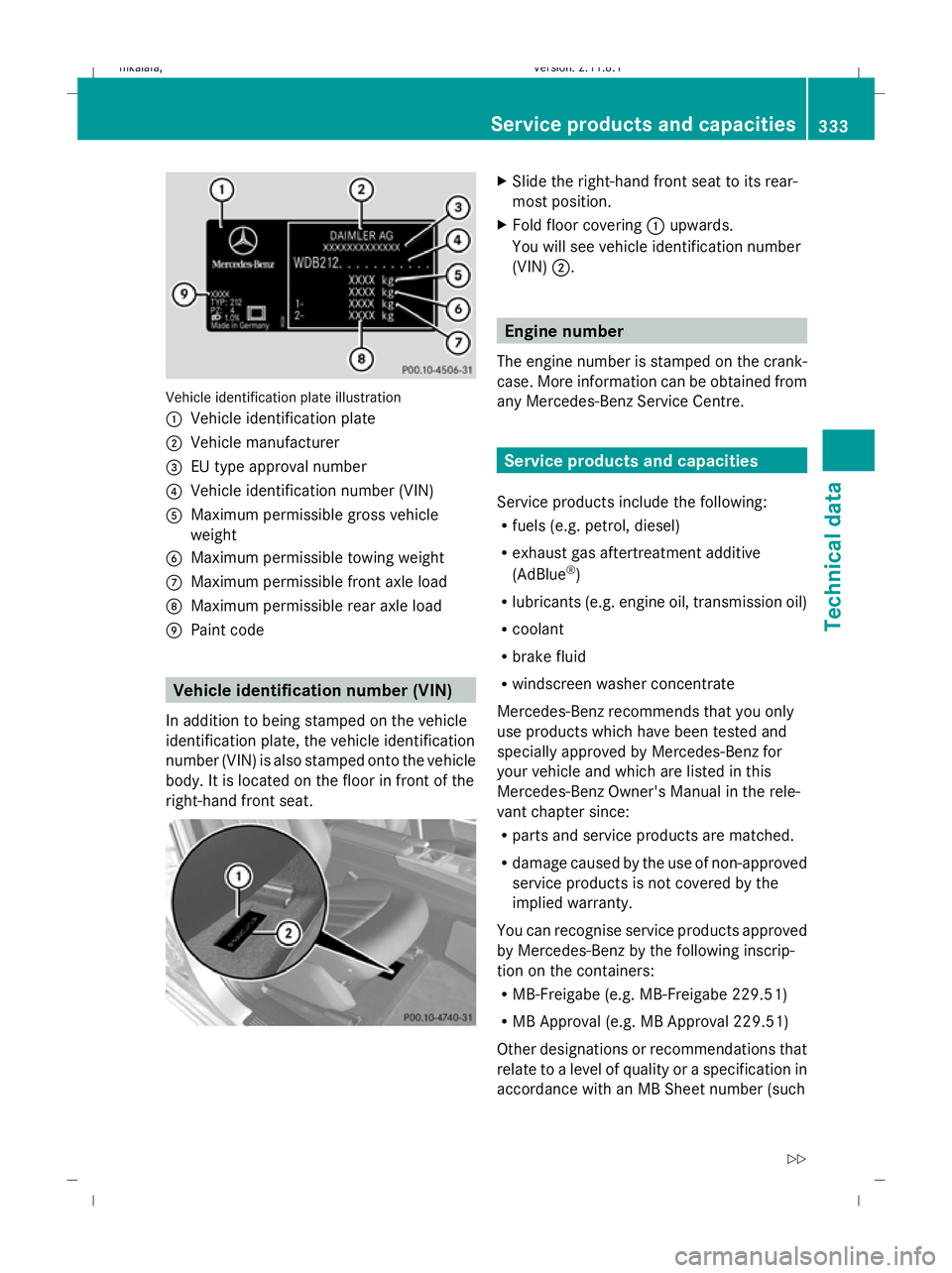
Vehicle identification plate illustration
:
Vehicle identification plate
; Vehicle manufacturer
= EU type approval number
? Vehicle identification number (VIN)
A Maximum permissible gross vehicle
weight
B Maximum permissible towing weight
C Maximum permissible front axle load
D Maximum permissible rear axle load
E Paint code Vehicle identification number (VIN)
In addition to being stamped on the vehicle
identification plate, the vehicle identification
number (VIN) is also stamped onto the vehicle
body. It is located on the floor in front of the
right-hand front seat. X
Slide the right-hand front seat to its rear-
most position.
X Fold floor covering :upwards.
You will see vehicle identification number
(VIN) ;. Engine number
The engine number is stamped on the crank-
case. More information can be obtained from
any Mercedes-Benz Service Centre. Service products and capacities
Service products include the following:
R fuels (e.g. petrol, diesel)
R exhaust gas aftertreatment additive
(AdBlue ®
)
R lubricants (e.g. engine oil, transmission oil)
R coolant
R brake fluid
R windscreen washer concentrate
Mercedes-Benz recommends that you only
use products which have been tested and
specially approved by Mercedes-Benz for
your vehicle and which are listed in this
Mercedes-Benz Owner's Manual in the rele-
vant chapter since:
R parts and service products are matched.
R damage caused by the use of non-approved
service products is not covered by the
implied warranty.
You can recognise service products approved
by Mercedes-Benz by the following inscrip-
tion on the containers:
R MB-Freigabe (e.g. MB-Freigabe 229.51)
R MB Approval (e.g. MB Approval 229.51)
Other designations or recommendations that
relate to a level of quality or a specification in
accordance with an MB Sheet number (such Service products and capacities
333Technical data
212_AKB; 2; 4, en-GB
mkalafa, Version: 2.11.8.1 2009-05-05T14:17:16+02:00 - Seite 333 Z
Dateiname: 6515346702_buchblock.pdf; erzeugt am 07. May 2009 14:17:32; WK
Page 341 of 373
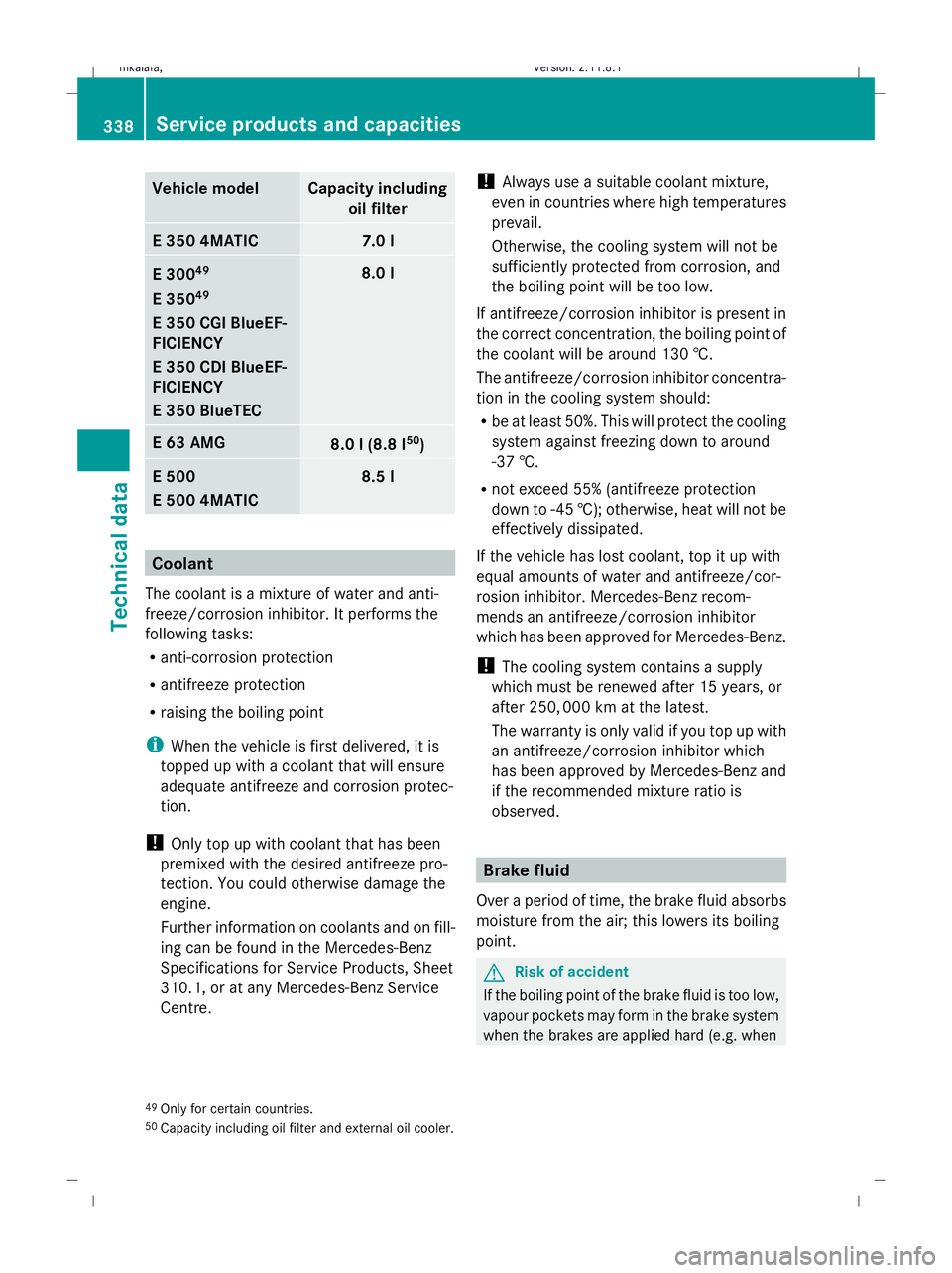
Vehicle model Capacity including
oil filter E 350 4MATIC 7.0 l
E 300
49
E 350 49
E 350 CGI BlueEF-
FICIENCY
E 350 CDI BlueEF-
FICIENCY
E 350 BlueTEC 8.0 l
E 63 AMG
8.0 l (8.8 l
50
) E 500
E 500 4MATIC 8.5 l
Coolant
The coolant is a mixture of water and anti-
freeze/corrosion inhibitor. It performs the
following tasks:
R anti-corrosion protection
R antifreeze protection
R raising the boiling point
i When the vehicle is first delivered, it is
topped up with a coolant that will ensure
adequate antifreeze and corrosion protec-
tion.
! Only top up with coolant that has been
premixed with the desired antifreeze pro-
tection. You could otherwise damage the
engine.
Further information on coolants and on fill-
ing can be found in the Mercedes-Benz
Specifications for Service Products, Sheet
310.1, or at any Mercedes-Benz Service
Centre. !
Always use a suitable coolant mixture,
even in countries where high temperatures
prevail.
Otherwise, the cooling system will not be
sufficiently protected from corrosion, and
the boiling point will be too low.
If antifreeze/corrosion inhibitor is present in
the correct concentration, the boiling point of
the coolant will be around 130 †.
The antifreeze/corrosion inhibitor concentra-
tion in the cooling system should:
R be at least 50%. This will protect the cooling
system against freezing down to around
-37 †.
R not exceed 55% (antifreeze protection
down to -45 †); otherwise, heat will not be
effectively dissipated.
If the vehicle has lost coolant, top it up with
equal amounts of water and antifreeze/cor-
rosion inhibitor. Mercedes-Benz recom-
mends an antifreeze/corrosion inhibitor
which has been approved for Mercedes-Benz.
! The cooling system contains a supply
which must be renewed after 15 years, or
after 250, 000 km at the latest.
The warranty is only valid if you top up with
an antifreeze/corrosion inhibitor which
has been approved by Mercedes-Benz and
if the recommended mixture ratio is
observed. Brake fluid
Over a period of time, the brake fluid absorbs
moisture from the air; this lowers its boiling
point. G
Risk of accident
If the boiling point of the brake fluid is too low,
vapour pockets may form in the brake system
when the brakes are applied hard (e.g. when
49 Only for certain countries.
50 Capacity including oil filter and external oil cooler. 338
Service products and capacitiesTechnical data
212_AKB; 2; 4, en-GB
mkalafa
,V ersion: 2.11.8.1
2009-05-05T14:17:16+02:00 - Seite 338
Dateiname: 6515346702_buchblock.pdf; erzeugt am 07. May 2009 14:17:33; WK
Page 342 of 373
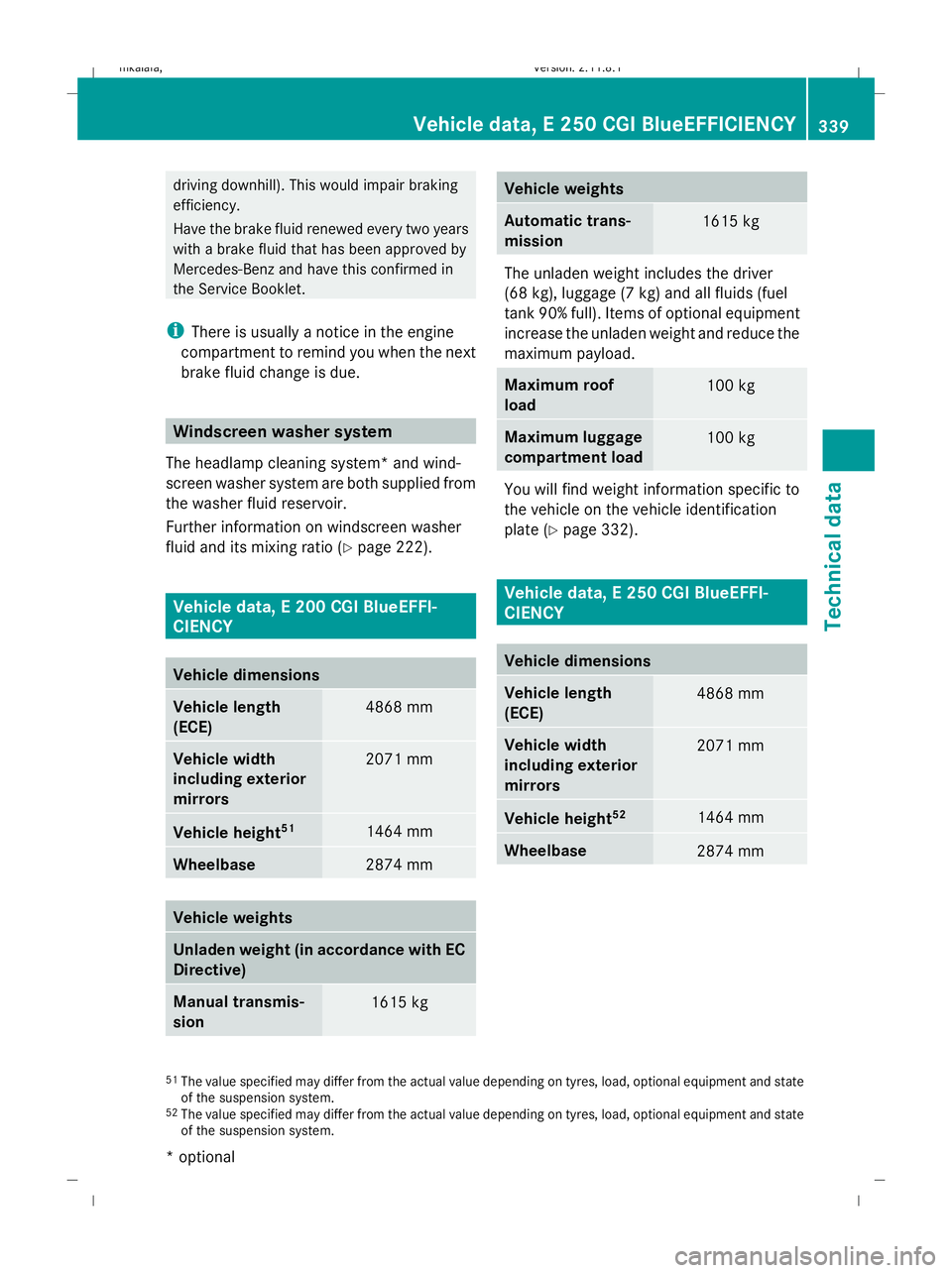
driving downhill). This would impair braking
efficiency.
Have the brake fluid renewed every two years
with a brake fluid that has been approved by
Mercedes-Benz and have this confirmed in
the Service Booklet.
i There is usually a notice in the engine
compartment to remind you when the next
brake fluid change is due. Windscreen washer system
The headlamp cleaning system* and wind-
screen washer system are both supplied from
the washer fluid reservoir.
Further information on windscreen washer
fluid and its mixing ratio ( Ypage 222). Vehicle data, E 200 CGI BlueEFFI-
CIENCY
Vehicle dimensions
Vehicle length
(ECE)
4868 mm
Vehicle width
including exterior
mirrors
2071 mm
Vehicle height
51 1464 mm
Wheelbase
2874 mm
Vehicle weights
Unladen weight (in accordance with EC
Directive)
Manual transmis-
sion
1615 kg Vehicle weights
Automatic trans-
mission
1615 kg
The unladen weight includes the driver
(68 kg), luggage (7 kg) and all fluids (fuel
tank 90% full). Items of optional equipment
increase the unladen weight and reduce the
maximum payload.
Maximum roof
load
100 kg
Maximum luggage
compartment load
100 kg
You will find weight information specific to
the vehicle on the vehicle identification
plate (Y
page 332). Vehicle data, E 250 CGI BlueEFFI-
CIENCY
Vehicle dimensions
Vehicle length
(ECE)
4868 mm
Vehicle width
including exterior
mirrors
2071 mm
Vehicle height
52 1464 mm
Wheelbase
2874 mm
51
The value specified may differ from the actual value depending on tyres, load, optional equipment and state
of the suspension system.
52 The value specified may differ from the actual value depending on tyres, load, optional equipment and state
of the suspension system. Vehicle data, E 250 CGI BlueEFFICIENCY
339Technical data
* optional
212_AKB; 2; 4, en-GB
mkalafa,
Version: 2.11.8.1 2009-05-05T14:17:16+02:00 - Seite 339 Z
Dateiname: 6515346702_buchblock.pdf; erzeugt am 07. May 2009 14:17:33; WK
Page 361 of 373
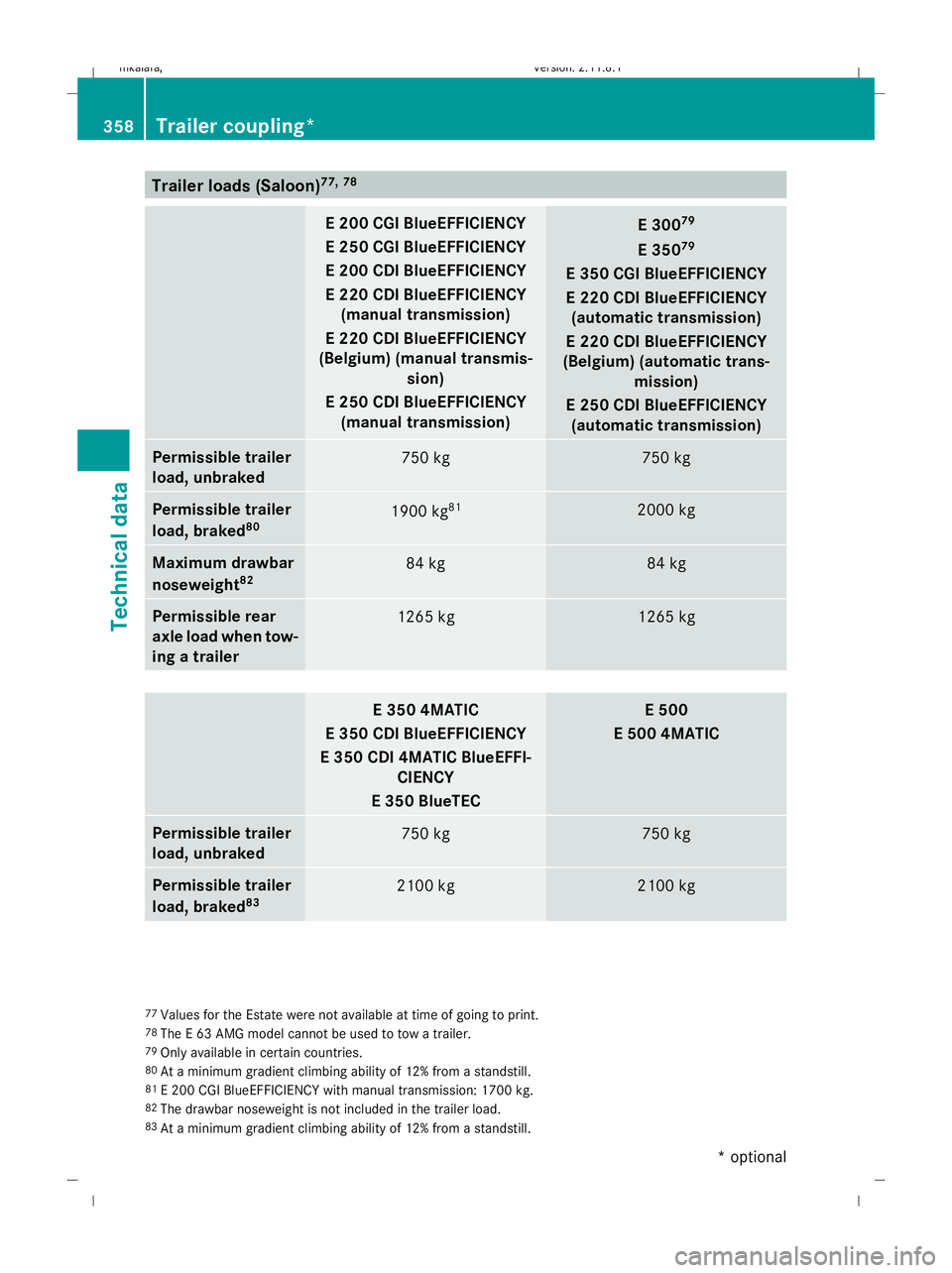
Trailer loads (Saloon)
77
,78 E 200 CGI BlueEFFICIENCY
E 250 CGI BlueEFFICIENCY
E 200 CDI BlueEFFICIENCY
E 220 CDI BlueEFFICIENCY (manual transmission)
E 220 CDI BlueEFFICIENCY
(Belgium) (manual transmis- sion)
E 250 CDI BlueEFFICIENCY (manual transmission) E 300
79
E 350 79
E 350 CGI BlueEFFICIENCY
E 220 CDI BlueEFFICIENCY (automatic transmission)
E 220 CDI BlueEFFICIENCY
(Belgium) (automatic trans- mission)
E 250 CDI BlueEFFICIENCY (automatic transmission) Permissible trailer
load, unbraked 750 kg 750 kg
Permissible trailer
load, braked 80 1900 kg
81 2000 kg
Maximum drawbar
noseweight
82 84 kg 84 kg
Permissible rear
axle load when tow-
ing a trailer
1265 kg 1265 kg
E 350 4MATIC
E 350 CDI BlueEFFICIENCY
E 350 CDI 4MATIC BlueEFFI- CIENCY
E 350 BlueTEC E 500
E 500 4MATIC Permissible trailer
load, unbraked 750 kg 750 kg
Permissible trailer
load, braked 83 2100 kg 2100 kg
77
Values for the Estate were not available at time of going to print.
78 The E 63 AMG model cannot be used to tow a trailer.
79 Only available in certain countries.
80 At a minimum gradient climbing ability of 12% from a standstill.
81 E 200 CGI BlueEFFICIENCY with manual transmission: 1700 kg.
82 The drawbar noseweight is not included in the trailer load.
83 At a minimum gradient climbing ability of 12% from a standstill. 358
Trailer coupling*Technical data
* optional
212_AKB; 2; 4, en-GB
mkalafa,
Version: 2.11.8.1 2009-05-05T14:17:16+02:00 - Seite 358
Dateiname: 6515346702_buchblock.pdf; erzeugt am 07. May 2009 14:17:37; WK
Page 365 of 373
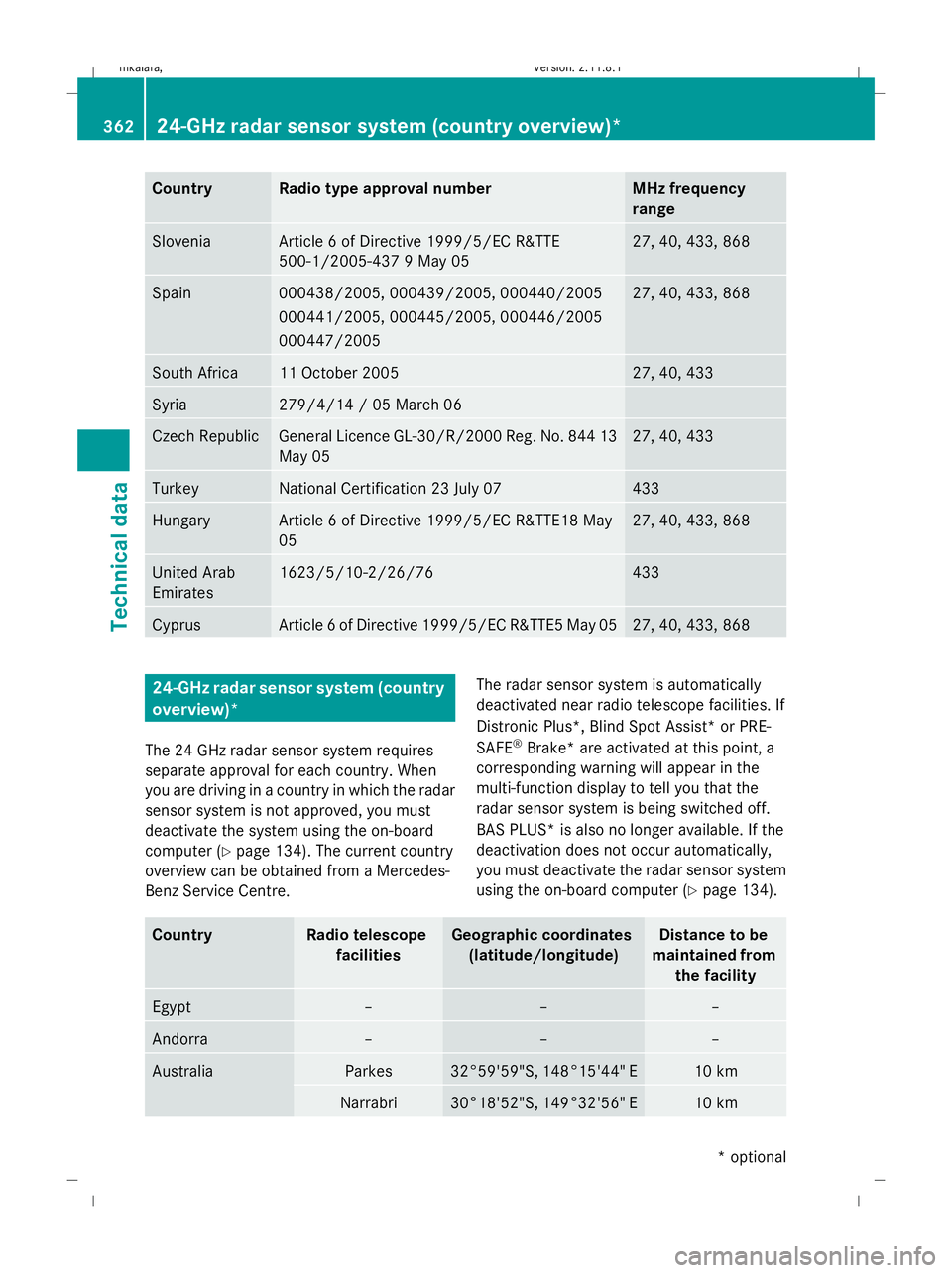
Country Radio type approval number MHz frequency
range
Slovenia Article 6 of Directive 1999/5/EC R&TTE
500-1/2005-437 9 May 05 27, 40, 433, 868
Spain 000438/2005, 000439/2005, 000440/2005
000441/2005, 000445/2005, 000446/2005
000447/2005 27, 40, 433, 868
South Africa 11 October 2005 27, 40, 433
Syria 279/4/14 / 05 March 06
Czech Republic General Licence GL-30/R/2000 Reg. No. 844 13
May 05 27, 40, 433
Turkey National Certification 23 July 07 433
Hungary Article 6 of Directive 1999/5/EC R&TTE18 May
05 27, 40, 433, 868
United Arab
Emirates 1623/5/10-2/26/76 433
Cyprus Article 6 of Directive 1999/5/EC R&TTE5 May 05 27, 40, 433, 868
24-GHz radar sensor system (country
overview)*
The 24 GHz radar sensor system requires
separate approval for each country. When
you are driving in a country in which the radar
sensor system is not approved, you must
deactivate the system using the on-board
computer (Y page 134). The current country
overview can be obtained from a Mercedes-
Benz Service Centre. The radar sensor system is automatically
deactivated near radio telescope facilities. If
Distronic Plus*, Blind Spot Assist* or PRE-
SAFE
®
Brake* are activated at this point, a
corresponding warning will appear in the
multi-function display to tell you that the
radar sensor system is being switched off.
BAS PLUS* is also no longer available. If the
deactivation does not occur automatically,
you must deactivate the radar sensor system
using the on-board computer (Y page 134).Country Radio telescope
facilities Geographic coordinates
(latitude/longitude) Distance to be
maintained from the facility Egypt – – –
Andorra – – –
Australia Parkes 32°59'59"S, 148°15'44" E 10 km
Narrabri 30°18'52"S, 149°32'56" E 10 km362
24-GHz radar sensor system (country overview)*Technical data
* optional
212_AKB; 2; 4, en-GB
mkalafa,
Version: 2.11.8.1 2009-05-05T14:17:16+02:00 - Seite 362
Dateiname: 6515346702_buchblock.pdf; erzeugt am 07. May 2009 14:17:38; WK